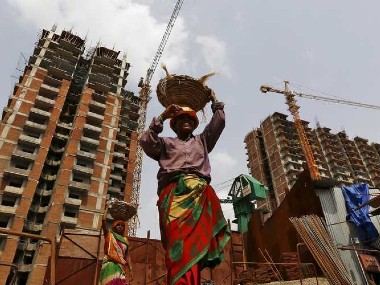COVID-19 is far more than a health crisis. The economic crisis–a severe fallout of the virus–is grim, and much grimmer for developing countries like India. The pandemic has already exposed the health vulnerabilities facing India, especially its rural poor, and urban slum dwellers. As a measure to contain the community transmission of the virus, the government announced a nationwide lockdown which was extended twice to continue through 17 May. The impact of a little less than two-month lockdown is turning out to be immense. Since economic activities have come to a standstill, factories are not running, establishments are closed, and most markets are shut, there is a disruption in work, wages/income and food–all three interconnected–for crores of people in India. Almost 90 percent of workers in India work in the informal economy–that part of the economy which thrives on daily work, and daily cash, with little provisions of employment protection. Like demonetisation, the current lockdown has exposed millions of workers and their families to starvation, hunger, death and very bleak future prospects. In this article, an attempt is made to bring to the fore discussions on the employment scenario and household income in the pre-lockdown and post-lockdown periods, with a motivation to spell out the probable consequences on the Indian economy, especially the informal economy including the poor, the marginalised. Rising unemployment, falling labour force India’s track of employment creation has not been very impressive at least since the 2000s. Economic growth has not been able to deliver jobs. For example, in the 2000s, the GDP growth had risen to 7 percent but employment growth decreased to less than 1 percent. Additionally, between 2012 and 2018, India lost 6.1 million jobs. The 6.1 percent rise in unemployment to a 45-year-end high hit the headlines just before the 2019 General elections. The coronavirus pandemic comes as huge shock to the labour market in India, denting the employment scenario and threatening the survival of millions of workers and their families. According to the latest survey of the Centre For Monitoring Indian Economy (CMIE), the overall rate of unemployment has increased from 8.4 percent to 23.8 percent in the week ending 29 March. In absolute terms, the number of unemployed people has risen from 32 million to 38 million. The corresponding figures for urban and rural areas are 30 percent and 21 percent. [caption id=“attachment_8195181” align=“alignleft” width=“380”]
 Representational image. Reuters[/caption] We have culled the data from CMIE on labour force, employment and unemployment to put it in graphical form. Around one-fourth of the total working age population, i.e 285 million people out of 1,003 million were working in the first lockdown week. Before lockdown the number was 404 million. It means the rest 119 million people lost their jobs within the starting week of the lockdown. The assumptions made out of the impact shows that around one-third of India’s households could be facing a relentless livelihood crises. As the figure below shows, the rate of employment in January 2016 was 40.7 percent and this remains almost unchanged up to February 2020 with the rate at 40 percent. But the figure changed in March 2020 after the first week of lockdown and reached 29.9 percent and further declined to 27 percent in April 2020. If we consider the occupational structure, we find that around 40 million urban informal workers are committed in ten highly susceptible occupations including a small shops salespersons, labourers in construction, manufacturing and transport, domestic helpers, housekeeping, painters, street vendors, garbage collectors, restaurant service workers, and market and stall salespersons. These workers are worse hit during the lockdown and consequently their families. Pronab Sen, the former chief statistician of India was reported as saying that around 50 million workers might have lost their jobs within two weeks after the lockdown. India’s problem of rising job loss and unemployment may accentuate the problem of poverty. Around 400 million workers employed in the unorganised economy are at a risk of falling deeper into poverty during the crisis, an ILO report warns. Labour force participation rate (LFPR has also come down drastically in the weeks following lockdown)–an estimate of both employed and those who are actively looking for a job but not getting one, shows a decline. A decline in LFPR indicates that people have stopped looking for a job, and have opted out of the labour market. LPR stood at 44.6 percent in January 2016. After the lockdown in March 2020, the percentage in labour force participation declined to 39.2 percent and further to 35.5 percent in the second week of April. (see graph above) We get a sense of the magnitude of the crisis by looking at the share of formal and informal employment. Going by the data released in the Periodic Labour Force Survey of 2017-18, more than 90 percent of the workers are from the informal sector. Only less than 10 percent are workers from the formal sector who can switch to ‘work from home’ mode in this pandemic. For most informal workers, it’s a daily hand-to-mouth existence. These workers have little to no savings to eke out a living through a prolonged lockdown.
Lack of job security, paid leave, or job contract makes them vulnerable to vagaries of the labour market. The informal sector leads to a state of destitution, hunger, starvation and even death, if not protected with an immediate social safety net.
Exodus of migrant workers: A fallout of lockdown Migrant workers make up a major part of the employment force in India in the unorganised sector. It is difficult to estimate the total number of migrant workers in India. The reason for this is because there is no portal for the registration of migrant workers. By some estimates, India has around 40-50 million seasonal migrants. These are the ones in distress the most. The exodus of migrant workers either at Anand Vihar in New Delhi or at Bandra station in Mumbai is a manifestation of loss of livelihoods. Many of these workers, having lost work and hence income, started trudging on foot back to their villages in the hope of surviving the lockdown. Some were reported to have died. Though some immediate steps were taken by some state governments to provide daily food rations to migrant workers, reports say that jobless migrants find it increasingly difficult to survive, let alone lead a dignified life. Jan Sahas, a non-governmental organisation, has done a survey on the question of inadequate relief measures for migrant workers. The labour and employment ministry has asked the chief ministers and the governors of the states to release funds into the account of construction workers using the cess collected by the building and other construction worker’s welfare board. Jan Sahas found 94 percent labourers did not have the BCOW (Building and Other Construction Workers) cards, making them ineligible for any transfer; 14 percent did not have ration cards, while 17 percent did not have bank accounts. The NGO also claimed that if represent the data of 55 million labourers in the construction sector, then more than 51 million labourers will not have access to any benefits.
In a telephonic interview with 3,196 migrant construction workers from North and Central India, it was found that unregistered labourers are still in a precarious situation. About 62 percent of the respondents do not have any information about welfare measures and 37 percent workers do not know how to access the existing schemes provided by the government.
As far as the problem of ration cards is concerned, those who have ration cards of their native states and are stuck at other destinations must be provided with the delivery of rations. And those without ration cards should also receive free rations for the next six months, the organisation said. The Jan Sahas said, the general status of the migrants in a society is that they are excluded from all social safety mechanisms. It is unacceptable that there is no directive issued by the state government concerning the welfare of migrant workers. No welfare schemes are provided until it becomes impossible to avoid the pictures of large groups of migrant workers walking in deplorable conditions. Impact on household’s income The nationwide lockdown, much to expectations, has hit household’s income. All kinds of households–whether based on primary, secondary and tertiary activity or region-wise rural as well as urban–have received a blow. The CMIE provides a quarterly estimate of proportions of households classified under ‘no change in income’, ‘fall in income’ and ‘rise in income’. The figure below shows that there is a steep rise in proportions of households reporting ‘fall in income’ after January 2020. The proportion has increased from a mere 12 percent in April 2019 to a whopping 48 percent by April 2020. In ‘no change in income’ category, there were 53.3 percent households in April 2019 but after two quarters, the proportion rose to 60.9 percent in July 2019. In pre-lockdown January 2020, it was 55.8 percent, but in post-lockdown period-April 2020 it declined steeply to about 44 percent. Similarly, in post-lockdown period, the proportions of households reporting ‘rise in income’ have come down drastically to 11 percent, as opposed to 35 percent in April 2019. This simple statistic reveals the impact of halting of economic activities and the consequent loss of livelihoods to millions of households in India. Health hazards, economic risks COVID-19 has posed serious challenges for the Indian economy–both in terms of health hazards and economic risks. With lockdown extended further till 17 May, its implications would be grave, given the large size of population and heavy dependence of workers in the informal economy. Due to uncertainties, measuring the full impact of this crisis is not possible now. Its impact will begin to show only in times to come. Nonetheless, preparedness in terms of policy responses is imperative in order to contain the spread of virus and further economic slowdown as well. Most of the measures taken by the government, such as targeted cash transfers and tax benefits, exclude the vast army of informal economy workers. In such a case, only a universal self-targeting welfare scheme is the effective measure. The idea of Universal Basic Income and a national-level Employment Guarantee Scheme on the lines of the already successful MGNREGA, need to be pushed by the government in order to respond effectively to the pandemic costs bearing upon the poor and the marginalised. (Khan is a research scholar at Department of Economics in AMU, Aligarh; Mansoor is a doctoral fellow at Centre for Development Studies, Trivandrum Kerala)


)

)
)
)
)
)
)
)
)



